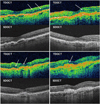Comparison of optical coherence tomography assessments in the comparison of age-related macular degeneration treatments trials
- PMID: 24835760
- PMCID: PMC4515372
- DOI: 10.1016/j.ophtha.2014.04.020
Comparison of optical coherence tomography assessments in the comparison of age-related macular degeneration treatments trials
Abstract
Objective: To determine agreement between spectral-domain (SD) and time-domain (TD) optical coherence tomography (OCT) image assessments by certified readers in eyes treated for neovascular age-related macular degeneration (AMD).
Design: Cross-sectional study within the Comparison of AMD Treatments Trials (CATT).
Participants: During year 2 of CATT, 1213 pairs of SD OCT and TD OCT scans were compared from a subset of 384 eyes.
Methods: Masked readers independently graded OCT scans for presence of intraretinal fluid (IRF), subretinal fluid (SRF), and sub-retinal pigment epithelium (RPE) fluid and performed manual measurements of retinal, SRF, and subretinal tissue complex thicknesses at the foveal center.
Main outcome measures: Presence of fluid was evaluated with percent agreement, κ coefficients with 95% confidence intervals (CIs), and McNemar tests. Thickness measurements were evaluated with mean difference (Δ) ±95% limits of agreement and intraclass correlation coefficients (ICCs) with 95% CIs.
Results: Between SD OCT and TD OCT, agreement on presence of any fluid was 82% (κ = 0.46; 95% CI, 0.40-0.52), with 5% more SD OCT scans demonstrating fluid (P<0.001). Agreement on presence of SRF was 87% and sub-RPE fluid was 80%, with more SD OCT scans demonstrating fluid (both P < 0.001). Agreement on IRF was 73% (κ = 0.47; 95% CI, 0.42-0.52), with 6% more TD OCT scans demonstrating fluid (P < 0.001). Between SD OCT and TD OCT, mean thickness of the retina was Δ = 5±67 μm, SRF was Δ = 1.5±35 μm, and subretinal tissue complex was Δ = 5±86 μm. Thickness measurements were reproducible for retina (ICC = 0.84; 95% CI, 0.83-0.86), SRF (ICC = 0.88; 95% CI, 0.86-0.89), and subretinal tissue complex (ICC = 0.91; 95% CI, 0.89-0.92), with ≤25-μm difference in these measurements in 71%, 94%, and 61% of paired scans, respectively.
Conclusions: Agreement on fluid presence and manual thickness measurements between paired scans from each OCT modality was moderate, providing a reasonable basis to compare CATT results with future SD OCT-based trials. Fluid was detected 5% more frequently with SD OCT, which may increase frequency of fluid-based treatment. Lower-resolution and artifactual interpretation of dark areas as cystoid edema may explain the greater frequency of IRF detected with TD OCT.
Trial registration: ClinicalTrials.gov NCT00593450.
Copyright © 2014 American Academy of Ophthalmology. Published by Elsevier Inc. All rights reserved.
Figures








References
-
- Hee MR, Baumal CR, Puliafito CA, et al. Optical coherence tomography of age-related macular degeneration and choroidal neovascularization. Ophthalmology. 1996;103:1260–1270. - PubMed
-
- Jaffe GJ, Caprioli J. Optical coherence tomography to detect and manage retinal disease and glaucoma. Am J Ophthalmol. 2004;137:156–169. - PubMed
-
- Chen TC, Cense B, Pierce MC, et al. Spectral domain optical coherence tomography: ultra-high speed, ultra-high resolution ophthalmic imaging. Arch Ophthalmol. 2005;123:1715–1720. - PubMed
Publication types
MeSH terms
Substances
Associated data
Grants and funding
LinkOut - more resources
Full Text Sources
Other Literature Sources
Medical
Miscellaneous

